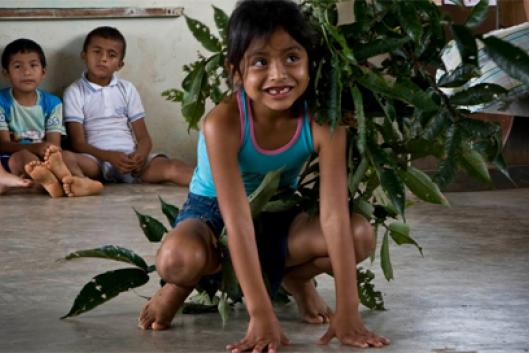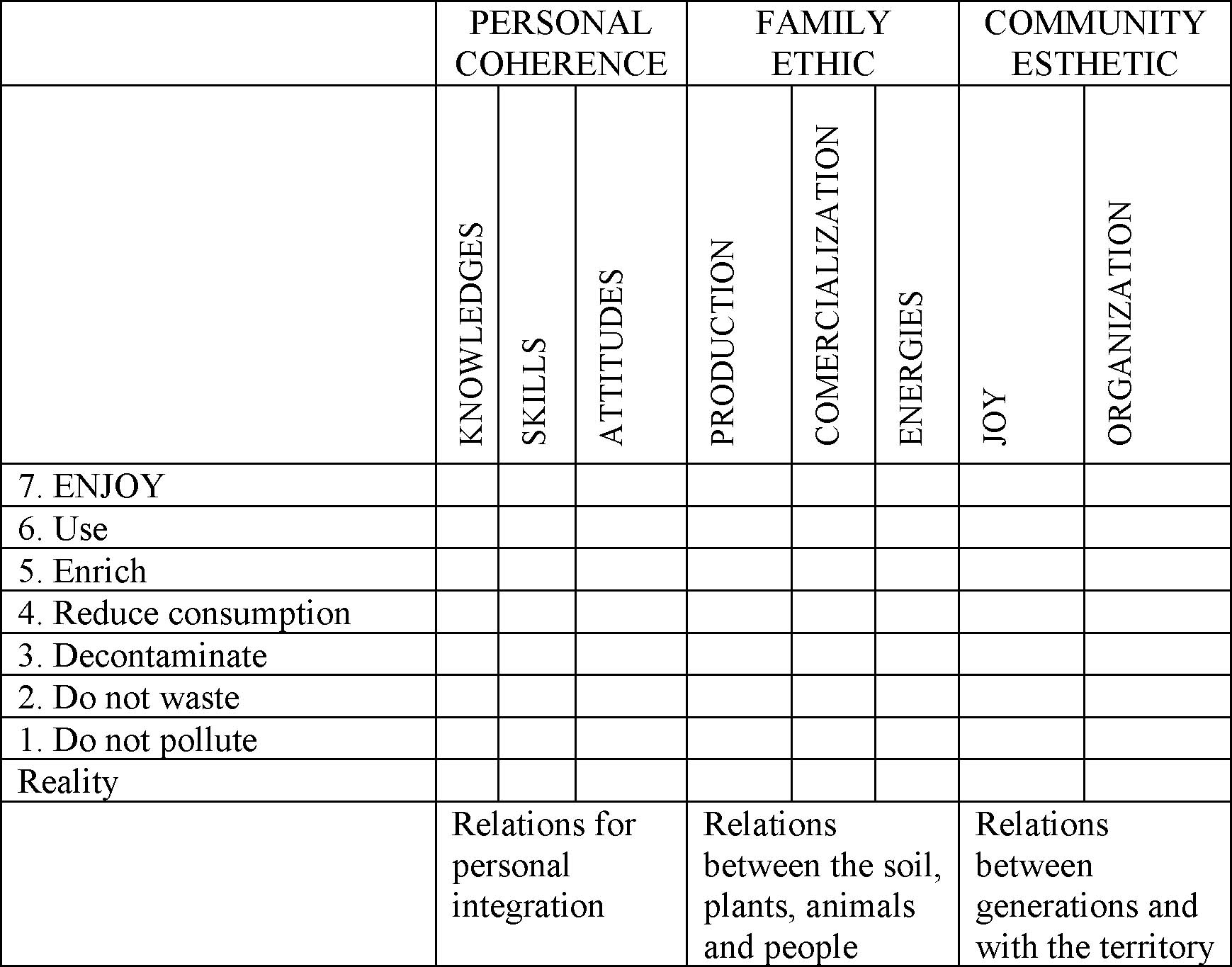In communities on the border between Ecuador and Colombia that live under the influence of armed conflict, monoculture fruit tree plantations soaked pesticides, and/or oil drilling – and therefore, in the midst of contamination – the social fabric has deteriorated to critical degrees. In Ecuador, in the last 10 years, there have been 8,688 suicides, most of them young people, primarily women, and most often in rural areas. However, it is estimated that for every suicide reported, there have been another four not recorded as such, and another 20 attempted suicides. Poverty, created as a means of domination, has spread fear among thousands of families, whose dreams have been lost.
This could lead us to ask, what is the energy missing from these peasant and indigenous communities, when their members choose to turn out the lights on their lives forever?
The ‘Environmental Clinic’
In 2006, after seeing how the drawings done by children affected by the Colombian conflict had turned from colour to black and white, and how they painted faces without eyes, ears or mouths, as if they no longer wanted to see, hear or speak, we decided to create a space where the goal was the repair of the social fabric through art and joy, the recovery of family ties and ties with nature through affection, and the reconstruction of the person through education. This led to the emergence in 2008 of what we call the Environmental Clinic. We chose the name clinic, which is derived from the Greek word for “bed”, because when nature is “sick”, its health must be recovered in order to maintain the health of the population. It is a space for discussion, where professionals from different fields address the problems presented by the population, in a similar way to the human rights clinics in some law schools, but with a multidisciplinary approach.
The work done by the Clinic has included community studies carried out alongside the affected people, which has made it possible to uncover the chains of aggression against the communities. In Pimampiro-Loma de Tigre, for example, it could be clearly observed that behind the various illnesses afflicting the communities, there was an obvious multi-exposure to poverty, violence, sadness and fear. Behind these, in turn, was the creation of privileges for a small few, granted by the oil companies, which were derived from plunder and the destruction of the social fabric and, simultaneously, from the destruction of self-esteem, the solidarity once offered by the social fabric, and the values and principles that had provided community cohesion. But what became even clearer was how this process began with the imposition of extractivist policies which for decades, and until today, have prioritized industrial activity over policies to guarantee people’s rights, reinforced by the military presence deployed in the region to ensure continued exploitation. The process is Imposition-Plunder-Exposure.
Therefore, in the joint search to re-encounter, construct, maintain and re-affirm this collective “energy-light”, we developed proposals that did not involve alternative energies, but rather alteRAtive energies, that is, energies with the capacity to alter or change our lives for the better.
Some indigenous peoples believe that communities should be small, so that all members, including children, have decision-making power. The process of deciding, of creating, is transformative, because it increases self-esteem and makes it possible to take on responsibilities. This stirs up our internal energy, it sparks enthusiasm, passion, the development of capacities. In the process of the development of alteRAtive alternatives, what is important is not so much the idea in itself, but rather the adoption of this idea with one’s own materials, adapted to the needs and the setting.
The Huipala Proposal: A system of Integral Alterative Community Repair
To develop the Huipala Proposal (1) we decided to create seven levels of work, starting from the horizon of the reality in which we live and aiming towards the utopian horizon we want to reach. Each step is a step up towards that desired utopia: 0. Reality, 1. Do not pollute, 2. Do not waste, 3. Decontaminate, 4. Reduce consumption, 5. Enrich, 6. Use, and 7. Enjoy. But we also proposed three main columns: the personal, family and community/organizational levels. We believe it is important to give these spaces special attention, since they have been deeply fragmented by an economic model that solely places priority on money instead of people or nature.
The meaning of “rich”
Food can be rich and not expensive, but we value the fact that it is filling and flavourful. People can be rich in experience because they have lived a lot or very intensely, although they may not be wealthy. Soil is rich in nutrients because it contains a lot of them, but that does not mean that it has a higher economic value. An organization can be enriched if it increases the ties that join its members together, yet sometimes when organizations obtain economic resources they are impoverished and destroyed. There are many people living in the forest who feel poor because they lack economic resources, but they live surrounded by the greatest diversity in the world. It is important not to confuse value with price.
At the personal level, we placed value on knowledge, skills and attitudes, and created a column for each of these, with the expectation that building relations among the three will bring us closer to COHERENCE. At the family level, we decided to value the means of production, the criteria for marketing and the energies used, with the intent that relating the soils with seeds, plants, animals and persons would lead to the emergence of an ETHIC of relationships. At the community level, we valued the building of relationships within the social fabric and with the territory through joy and organization, in order to create an ESTHETIC that belongs to each place and gives it an identity.
In this way, the Huipala Proposal is laid out in a grid, with the aim of moving, at the personal level, from disregarding to valuing one’s own knowledge and skills; from felling incapable to creating art, and from selfishness to solidarity. In the realm of the family, moving from monoculture production to an integral approach to farming in which everything is related (soils, different plants, animals…); from giving up on marketing to self-management; and from the exhaustion of energies to participation with energies that are not only alternative but also alterative, which have the capacity to change our lives for the better. And at the community level, the idea is to move from fear to joy, and from the fragmentation of the social fabric to the consolidation of an organization that sees the need to address the problems that affect it and has the tools to solve them.
After five years of work we reflected on what we were doing, and in numerous group meetings we defined what should go into each square. This was how we put together and decided how to build this proposal. Various steps were identified, such as personal training plans that would help us in this process. Maps of the farms that made it possible for us to identify the relationships between crops, with the forest, with livestock or corrals to produce fertilizers; and maps of the community to identify areas at risk, areas in need of protection, places to watch the stars, trees to guard, etc., which would help us to join and intertwine the fragments into which our lives have often broken.
Fairs are organized that place value on our seeds, and on harvests as a way of feeding ourselves, and not merely something to be sold. We talk about eco-gastronomy, about mingas (2), about alterative energies, which help us to not contaminate the soils, but also to carry out studies that allow us to reflect on problems in order to begin to search for solutions. For the purpose of decontamination we also include healing therapies like Reiki (3) for adults, children and plants. We propose that within the family, decisions should be made by consensus, and not imposed by the “head” of the household. And we propose the recovery of acts of generosity and of exchange that does not involve money, such as the practice of bartering.
In the difficult climb towards utopia, more emphasis is placed on homemade technologies, on equity in time for rest within the family, on the recuperation of soils and integrated farms, on ensuring that young people have their own forms of expression, and that the community manages the water and forest, as well as its conflicts. Energy sovereignty is posed as a challenge; recreational gardens, local fairs; and at the same time, journalism and arts festivals are promoted as spaces for expression, while stressing that mobilization is crucial for processes of socio-environmental repair.
At the final level of work, level 7, would be activities corresponding to the utopian horizon proposed by each community, where all would be enjoyable experiences, and work would be a pleasure, given the ability to transform reality on the desired horizon.
This Huipala Proposal is not meant to be applied universally, since it was created as a response to the needs of a certain sector of the population in the Amazonian region of Ecuador, where there are certain problems it seeks to address. If the grid were used in another place, it would be necessary to work with the people affected to see how to move from the horizon of reality to the utopian horizon they dream of – which means beginning by collecting dreams as the destination point.
We also gave the grid the colours of the Huipala (to see the coloured grid, access the link below), which is why we gave the proposal this name. By doing so, we realized that these colours coincide with the chakras or centres of energy worked with in Reiki. That is why, in the right-hand column, we put the symbols of each of these chakras and what they represent (land, water, fire, air, ether, light and space), because they also symbolize our connection with nature and with the world of energies, beliefs, perceptions… and they help us make the grid circular and unite it with the beginning.
Final reflections
In places where extractive activities are imposed, companies tend to use the same tools that the Nazis used in the Holocaust and which the writer Primo Levi described to perfection: 1) ridiculing the population, 2) creating hierarchies of abuses, 3) destroying self-esteem, and 4) destroying any political, moral or judicial defence mechanisms that organizations could use to defend themselves. However, I have left until the end a fifth element that is actually the first one for them, the one with which the entire process of impoverishment begins: breaking down the internal solidarity in communities, by breaking the ties of the social fabric and the ties with nature that surrounds them. And that is why, today more than ever, what is needed is not only to recover this shattered solidarity, but to radicalize it.
Adolfo Maldonado, salud@accionecologica.org
Environmental Clinic, Acción Ecológica
More detailed information on the Huipala Proposal can be found (in Spanish) at: http://www.clinicambiental.org/index.php?option=com_content&view=category&layout=blog&id=3&Itemid=5
(1) Huipala: The chequered, rainbow-coloured flag that represents indigenous peoples in the Andean countries.
(2) Minga: Community work in which the members of the community join together to undertake a task that benefits everyone.
(3) Reiki: A Japanese art of healing through the hands.

